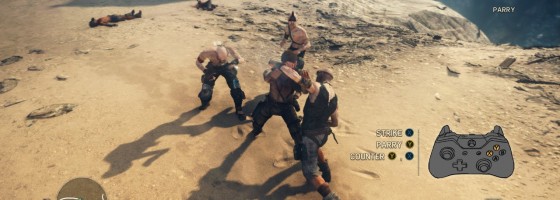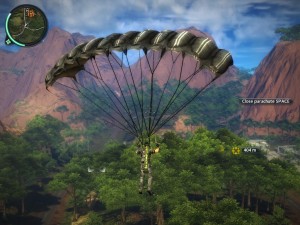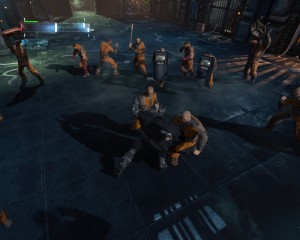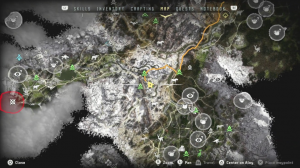Recently I played Horizon Zero Dawn thanks to the Black Friday sale. I was excited to get into this one considering all the praise it had at the start of 2017. However, the more I played of it the less I was enjoying myself. No matter how great the world design was, Horizon Zero Dawn is another example of one of the most easily copied design foundations in the last decade, and how developers are all borrowing from the same Ubisoft barrel.
Upen World:
The Assassin’s Creed franchise has done a lot to shape open world design since the 2nd game in 2009. As we’ve seen, when a genre or game becomes popular, it soon becomes the foundation for other AAA developers to borrow inspiration from.
The Upen World design has become a template that creates a wide, but unfulfilling world to explore, and we’re going to talk about each aspect of it.
1: Base Design
An Upen World Design game is always built on at minimum two systems of mechanics. The most popular ones are movement and combat (usually third person fighting). Some games like Mad Max and Horizon Zero Dawn will introduce a third system; driving and hunting respectively.
The base design of an Upen World becomes a part of every aspect of the rest of the game: Progression, content, and side questing are all grown from the base design. Now you may have noticed that I didn’t mention stealth as a whole system, and there’s a reason for it.
Stealth gameplay in these titles is usually tacked on to the combat system, instead of being its own thing. Notable exceptions would be the Assassin’s Creed series for blending in plain sight, or Batman’s “apex predator” design.
In most games that have stealth gameplay, it’s kept very bare bones and makes use of the same basic systems as movement.
The enemy AI is kept very basic, and so are the player’s actual options to be stealthy. The player’s ability to be sneaky is dependent on their progression in the game, and either makes it very weak or game breakingly powerful.
Regardless, the player always starts an Upen world game at the same state.
2: Progression
Every Upen world game has two forms of progression built into it. The first are new mechanics and tools that are either integrated into the base systems, or act as keys in the world. These options are tied to story progression and the player will never get them before the story introduces them. Most often if the upgrades are tied to combat they will be for specific enemy types or special weapons with limited use.
The second group is incremental or RPG-based growth. This can include upgrading weapons to do more damage, leveling up to unlock perks, getting more health, and improving carrying capacity. In order to keep pace with the story, these options are passively gated based on resources unlocked in the campaign or the scaling of enemies for experience.
One of the subtle aspects of Upen World Design is the fact that despite their action gameplay, a lot of the game’s back-end is built from RPG systems. You are always going to start out on the limited side, even playing characters like Batman, until you’ve leveled up enough.
The passive skills can radically change the game experience of playing the game, but not change how the player is controlling their character. Improving a character stat-wise simply augments what the player can do.
This is also where the stealth aspects of the game become overpowered. You’ll find that a number of skills for stealth greatly improve its effectiveness. This can get to the point where the player can trivialize any stealth section once the abstraction of the skills kicks in.
Basically, any aspect of the core systems that can be improved upon will usually have incremental-based upgrades to help show the character’s power progression over the course of playing the game.
3: Content
The actual content of an Upen world-styled game is where a lot of these titles fall apart for me. Going back to our first point, everything that the player can do in the world is dependent on the base systems. In turn, that limits the actual content that can be expanded upon to a few set gameplay mechanics.
You are going to be doing a lot of quests that involve killing X number of enemies, gathering X number of resources, or moving to specific points really fast. There is a lot of dead time in Upen world games of the player just wandering around to these specific quest points.
The main content or story missions will usually offer something more challenging or unique, but still within the confines of the base systems. Depending on how much time the player spends upgrading, it is very easy to break the game in terms of difficulty.
Another big flag for Upen world games is padding out the side content and just overwhelming the player with things to do. Raise your hand if you had to stop for a second when you open up the in-game map for the first time and see all the icons competing for your attention.
This is an OCD sufferer’s nightmare/dream come true. Unfortunately, all these diversions never directly improve the player or character. Instead, they will give you generic rewards like money or experience, which at some point will lose their purpose. Any quests that actually reward you with something meaningful are few in far between.
If you want to motivate someone to do something, then either the reward has to be promising or the action has to be engaging. For many Upen world games the first time you do a side quest it’s interesting; the 20th time not so much.
4: The Trimmings
Last but not least, this section is for all the little quirks that have begun showing up in all the Upen-styled games. To make things easier for everyone, I’m just going to list them here, and feel free to add your own in the comments below.
- Repetitive collection for basic supplies; usually for health, ammo or both
- Allowing the player diverse movement options that are only triggered at specific context sensitive points
- A side quest involving climbing something really high that reveals the map around the object
- Sections where the player must follow a slow moving NPC despite being much faster
- Taking away the player’s options and forcing them into a small area for a boss fight
- Collectibles hidden all over the world that someone would never find unless they buy the in-game detection
- Despite combat being a focus, very basic combat mechanics against enemies with abstracted advantages
- Pre order bonuses for outfits and weapons who range from being useless to completely overpowered
- Huge areas with very little actually happening; requiring fast travel to make any kind of progress in an acceptable time
Arkham’s Shadow of Assassin’s Zero Dawn:
The open world genre has become a mainstay of the AAA market, but it’s also become one of the most copied designs I’ve seen since the days of imitating GTA and JRPGs before it. I miss the days of Just cause, Spiderman and Hulk Ultimate Destruction. Each one did something different with the design to make them stand out from one another.
While the basics of the open-world genre are easily copied, it’s been awhile since we’ve seen a game really try to do something different with its base systems and not just be another Upen-styled game.
For you reading this: Can you think of great examples of modern open world design that did its own thing instead of just copying elements from Assassin’s Creed?





